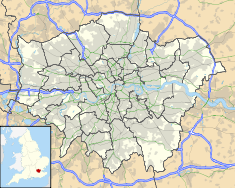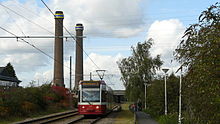- Croydon power stations
-
Croydon Power Station 
Croydon power station's cooling towers in 1973Location of Croydon Power Station Country England Location Croydon, Greater London Coordinates 51°22′44″N 0°07′16″W / 51.378826°N 0.121064°WCoordinates: 51°22′44″N 0°07′16″W / 51.378826°N 0.121064°W Commission date 1896 Decommission date 1984 Operator(s) Central Electricity Generating Board Power station information Primary fuel Coal-fired grid reference TQ307661 The Croydon power stations refers to a pair of demolished coal-fired power stations and to a gas-fired power station in the Purley Way area of Croydon, London. The coal-fired stations operated from 1896 until 1984, and the gas-fired station opened in 1999. Croydon B power station's chimneys have been retained as a local landmark.
Contents
History
Croydon A
The first power station built on the site, which would later become known as Croydon A power station, was opened in 1896.[1] The station was built near Croydon Gas Works by the Croydon Corporation. The generating equipment at the station was replaced in 1924, when low pressure equipment of 21 megawatts (MW) and high pressure equipment of 29 MW was installed, giving the station a generating capacity of 50 MW. This corresponded with the arrival of English Electric locomotive No.692, which used an overhead wire electric system, for the shunting of coal. In 1959 this was replaced by a steam locomotive from Littlebrook Power Station, built by W. G. Bagnall in 1946. In 1970, Croydon A was rarely active and was one of the few power stations in the country to still use wooden cooling towers.[2] It operated until 1973.[3]
Croydon B
Planning for a Croydon B power station was begun in 1939, with the architecture designed by Robert Atkinson. However, these plans were delayed by World War II.[4] Immediately after the end of the war, construction work began on the new station. The station was built by Sir Robert McAlpine & Sons, who also used two locomotives during the construction work; the first was Hudswell Clarke No.82, used between 1946 and 1948, the second was Hudswell Clarke No.55, used for the remainder of 1948.[2] The station was finally opened in 1950.[4]
The station originally had a generating capacity of 198 MW, but in the 1960s, a 140 MW gas turbine was installed at for peak use, bringing the generating capacity up to 338 MW.[2]
Once delivered to the station, coal was shunted by locomotives. Croydon B had a fleet of three shunting locomotives, all built by Peckett and Sons with the works numbers No.2103, No.2104 and No.2105. These three steam locomotives were superseded by diesels in the 1960s.[2]
Coal was originally brought to the station by rail, but during the 1970s coal was shipped down the coast from Northumberland to Kingsnorth and then transported to Croydon in up to twenty-five 10 ton lorries per day.[5]
It was decommissioned in 1984,[4] and in a disused state was used in the filming of parts of Terry Gilliam's 1985 film Brazil. The station was demolished in 1991 and an IKEA store was opened on the site. Two large chimneys were retained [4] and remain a local landmark.
Whilst it was being demolished a local band immortalised the power station, naming themselves after it. They had limited local success with whimsical tunes sending up local characters of the Croydon area. Croydon B on MySpace
Gas-fired station
In 1999 permission was given for an 80 MW gas-fired station at the gas-holder site at Factory Road,[3] about half a mile to the south-east of the 'B' station site.51°22′35″N 0°06′59″W / 51.37644°N 0.11637°W
The Valley Park Retail and Leisure Complex
In 1992, the area was regenerated into what is now known as "The Valley Park Retail and Leisure Complex."[6] The iconic towers which still stand to this day, are used by IKEA, who have based a store adjacent to them and now advertise on them.[4] The towers have been a guide to customers who have tried to get to IKEA, as they can be seen from miles away.[citation needed]
References
- ^ "GLIAS Walk: Croydon". GLIAS Notes and News - August 2001. Greater London Industrial Archaeology Society. http://www.glias.org.uk/news/195news.html.
- ^ a b c d Latham, J.B. (1970). The Locomotives of Croydon Gas & Electricity Works. Woking, Surrey: J.B. Latham.
- ^ a b Horne, M.A.C.. "London Area Power Supply". http://www.metadyne.co.uk/electricity.pdf.
- ^ a b c d e "Croydon 'B' Power Station, Purley Way, South London". Viewfinder. English Heritage. http://viewfinder.english-heritage.org.uk/search/detail.aspx?uid=17070.
- ^ POWER STATION, CROYDON (COAL SUPPLIES) HC Deb 28 March 1973, Hansard, vol 853 cc1491-500, [1]
- ^ "The Former Croydon B Power Station". GLIAS Notes and news — August 2003. Greater London Industrial Archaeology Society. http://www.glias.org.uk/news/207news.html.
Electricity generation in Greater London Power stations ClosedActon Lane · Barking A, B + C · Battersea · Blackwall Point · Brimsdown · Brunswick Wharf · Croydon A + B · Deptford · Fulham · Greenwich · Grosvenor Gallery · Hackney · Kingston · Lots Road · Neasden · Stepney · West Ham · WoolwichActiveClosedBulls BridgeFutureBarking Reach (extension)ActiveClosedShoreditchProposed/FutureActiveGreenwich (co-fires)ClosedActive
Organisations Categories:- London infrastructure
- Coal-fired power stations in England
- Natural gas-fired power stations in England
- Power stations in London
- Demolished power stations in the United Kingdom
- Former power stations in London
Wikimedia Foundation. 2010.



